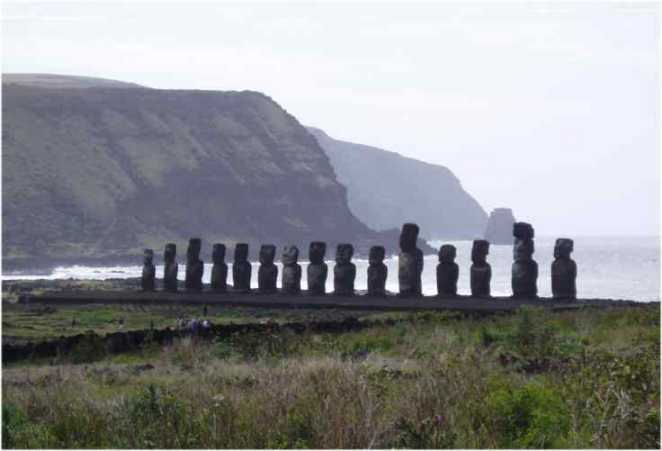
The Easter Island Moai is a series of monumental ancient statues that are iconic symbols of the island. They are typically carved from volcanic rock and are typically between 3 and 20 meters tall. The Moai have been the subject of much speculation and mystery.
Wiki:
https://en.wikipedia.org/wiki/Easter_Island
Here is more info about the statues:
https://www.bibliotecapleyades.net/arqueologia/eastern_island/easter02.htm
The official legend says that "Easter Island's Polynesian inhabitants arrived on Easter Island sometime near 1200 AD. They created a thriving and industrious culture, as evidenced by the island's numerous enormous stone moai and other artifacts. However, land clearing for cultivation and the introduction of the Polynesian rat led to gradual deforestation. By the time of European arrival in 1722, the island's population was estimated to be 2,000–3,000. European diseases, Peruvian slave raiding expeditions in the 1860s, and emigration to other islands, e.g. Tahiti, further depleted the population, reducing it to a low of 111 native inhabitants in 1877."
The official story is just too fantastic to be true.
- Question #1. How did people arrive on the island sometime near the 1200s? There is no forest, not a single tree which means no wood for tools, buildings, etc.
⛵The official explanation: The ancient Polynesian people were known for their seafaring ways, and Easter Island skeletons' DNA links their heritage. And when they came, there were palm trees.
https://www.pbs.org/wgbh/nova/article/pioneers-of-easter-island/
Debunk #1. While it is known that the ancient Polynesian moved between the islands in the Pacific, they traveled within the area of many islands near each other and it is known that they went as far as a few hundred miles from place to place. But Easter Island is 2,000 miles from the nearest land. It is too far to travel by canoe and the island is too small to get there statistically by accident or miracle.
- Question #2. How did rodents (rats) get into the island? Did Polynesian people have rats unnoticed in their canoes during their 2,000 miles travel to nowhere?
🐀 The official version says that trees were eliminated entirely by rodents by the 14-15 century. "Exactly how rats got on to the island is not known, although one theory is that they arrived as stowaways in the first canoes of Polynesian colonists. Once they arrived, the rats found palm nuts offered an almost unlimited high-quality food supply." And there were no predators…
Debunk #2: Regarding the theory about rats in Polynesian canoes... Taking what we know about rats => highly unlikely. Rats in the European ships in cargo holds => highly likely, there is much proof for that in literature. Additionally it is now proven that rodents coexist well with palm trees in South America and other areas.
"In spite of this significant rodent predation which is obviously much more extensive at La Campana than ever was the case on Rapa Nui (illustrated there by a high percentage of ungnawed nuts), the Jubaea palms at La Campana are able to regenerate, grow and form a dense palm woodland."
http://www.marklynas.org/wp-content/uploads/2011/09/Mieth-Bork_JAS_Rats-Humans.pdf
The article is relatively recent and it proves persuasively that rats are not related to tree elimination. Maybe the whole theory of rats on the island before the discovery by Europeans is wrong.
There are traces of burned soil - it may be due to natural causes (i.g. volcanoes). Millions of trees were cut by Europeans deliberately using iron tools more likely during late 1700s early 1800s and moved them away.
- Question #3: Drinking water: The island "has no permanent streams, and its three lakes are hard to reach and far from archaeological evidence of settlement." There is no evidence for ancient agriculture.
Before the aviation era and before the Panama Canal was built the Easter island was of great importance strategically during the late 1700s and 1800s due to its location. This can explain why there are so many myths around it.
🇳🇱 🇬🇧 Great powers were in competition to try to take over the island. The 1722 discovery by expedition of captain Roggeveen is most likely fake. The Roggeveen's expedition was in the Pacific at the time but unlikely the island was discovered by Roggeveen. The Roggeveen expedition main report was published in Britain only in 1838 to try and retroactively claim priority over the discovery.
🇪🇸 The island was first discovered by Europeans in 1770 by either French or Spanish expedition. On 15 November 1770 two Spanish ships, San Lorenzo and Santa Rosalia, under the command of Captain Don Felipe Gonzalez de Ahedo visited the island and then immediately it was captured and populated by Spanish in 3-4 consecutive expeditions. Most likely "native" people were brought to the island by these Spanish expeditions.
🇨🇱 Easter Island was annexed by Chile on 9 September 1888 by Policarpo Toro. Then the island was used as a remote prison and then managed by the Chilean Navy until 1966.
During this time, the island was closed to visitors.
🇨🇳 When we talked about the Terracotta army I speculated that the thousands of clay soldiers of the Terracotta army could be created relatively quickly by a Chinese labor camp. First as a copy project to keep prisoners busy, disciplined (and tired) and then the copy project was converted into a mega historic artifact project.
https://debunked.locals.com/post/4066892/hh2-the-terracotta-army-qa
Since Easter Island was used as a remote prison by Chile and it was closed to visitors we can imagine that the project was very similar to the Terracotta army project.
To keep prisoners busy – they were assigned with the task to create (copy statues). It’s possible there were 1-2 authentic statues to begin with and used as a template and everything else were copies which were created by prisoners. I estimate the project to create hundreds of statues with iron tools by hundreds of prisoners could take maybe 10-15 years. Possibly most of the statues were carved during the late 1800s or early 1900s by prisoners.
The Bellwether Counties argument is frequently cited on Twitter as evidence of an anomaly in the 2020 elections. In 2020, Trump won the popular vote in bellwether counties but lost the election, whereas in 2016, he won both the popular vote in these counties and the election.
The argument states: there are 15-20 bellwether counties, and the candidate who wins the popular vote in these counties will win the General Election.
This concept is flawed since the winner of the General Elections is not decided by the popular vote but by the Electoral College.
Interestingly, there is only one county in the United States that has consistently voted for the winner of the presidential election since 1980: Clallam County, WA.
I have identified 16 bellwether counties that have allegedly predicted the winner. Among them are three counties in South Carolina (Calhoun, Colleton, and Darlington), two in Ohio (Ottawa and Wood), and two in New Mexico (Valencia and Hidalgo).
What do bellwether counties predict, and what do they ...

People think that the Wikipedia is not a reliable source because anyone can edit any article.
📣 Actually, Wikipedia is an excellent source for information. However, it is important to learn how to use it effectively. Here are a couple of examples of how to dig into a Wikipedia article:
- You can check the Wikipedia article in other languages and cross-check the information using Google Translate. The information on the same subject may vary significantly depending on the language in which it is written.
- You can go through the history of Wikipedia article edits and compare the information. You may discover that some essential information was removed by an editor.
I plan WIKI to be a series of articles on the Debunked, where debunking can be done solely using Wikipedia.
Russian Collusion was an alleged interference between the Trump campaign and Russia to interfere in 2016 elections. The Mueller report "did not establish that members of the Trump campaign conspired or coordinated with the Russian government in its ...
On September 26, 1983, Stanislav Petrov, a duty officer who was stationed in the nuclear early-warning system of the Soviet Union saw a big RED BOLD message all over the screen - 5 missiles launched from bases in the United States.
Petrov saved the world by not reporting them to his superiors, and instead dismissed them as a false alarm. This was a breach of his instructions, a dereliction of duty. The safe thing to do would have been to pass the responsibility on, to refer up.
https://en.wikipedia.org/wiki/Stanislav_Petrov
https://www.bbc.com/news/world-europe-24280831
After the collapse of the Soviet Union, the story did get into the press. Mr Petrov received several international awards. But he does not think of himself as a hero 😆
"That was my job", he says. "But they were lucky it was me on shift that night."
📣 The story has all attributes of a classic hoax: only one source, no witnesses, unnecessary visual details that make the story sound more trustworthy.
🧵 Context 1: ...






















